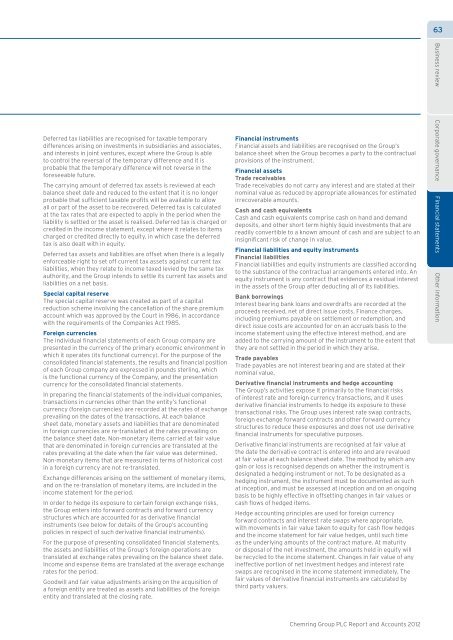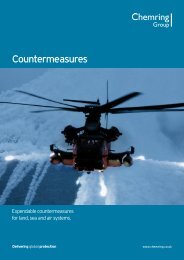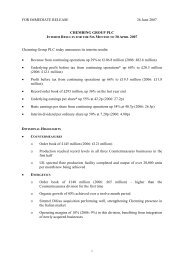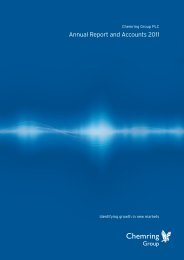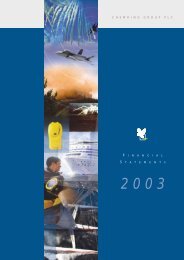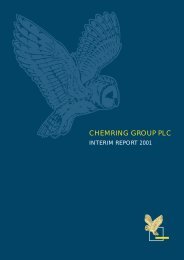Chemring Group PLC |Annual Report and Accounts 2012
Chemring Group PLC |Annual Report and Accounts 2012
Chemring Group PLC |Annual Report and Accounts 2012
You also want an ePaper? Increase the reach of your titles
YUMPU automatically turns print PDFs into web optimized ePapers that Google loves.
63<br />
Deferred tax liabilities are recognised for taxable temporary<br />
differences arising on investments in subsidiaries <strong>and</strong> associates,<br />
<strong>and</strong> interests in joint ventures, except where the <strong>Group</strong> is able<br />
to control the reversal of the temporary difference <strong>and</strong> it is<br />
probable that the temporary difference will not reverse in the<br />
foreseeable future.<br />
The carrying amount of deferred tax assets is reviewed at each<br />
balance sheet date <strong>and</strong> reduced to the extent that it is no longer<br />
probable that sufficient taxable profits will be available to allow<br />
all or part of the asset to be recovered. Deferred tax is calculated<br />
at the tax rates that are expected to apply in the period when the<br />
liability is settled or the asset is realised. Deferred tax is charged or<br />
credited in the income statement, except where it relates to items<br />
charged or credited directly to equity, in which case the deferred<br />
tax is also dealt with in equity.<br />
Deferred tax assets <strong>and</strong> liabilities are offset when there is a legally<br />
enforceable right to set off current tax assets against current tax<br />
liabilities, when they relate to income taxed levied by the same tax<br />
authority, <strong>and</strong> the <strong>Group</strong> intends to settle its current tax assets <strong>and</strong><br />
liabilities on a net basis.<br />
Special capital reserve<br />
The special capital reserve was created as part of a capital<br />
reduction scheme involving the cancellation of the share premium<br />
account which was approved by the Court in 1986, in accordance<br />
with the requirements of the Companies Act 1985.<br />
Foreign currencies<br />
The individual financial statements of each <strong>Group</strong> company are<br />
presented in the currency of the primary economic environment in<br />
which it operates (its functional currency). For the purpose of the<br />
consolidated financial statements, the results <strong>and</strong> financial position<br />
of each <strong>Group</strong> company are expressed in pounds sterling, which<br />
is the functional currency of the Company, <strong>and</strong> the presentation<br />
currency for the consolidated financial statements.<br />
In preparing the financial statements of the individual companies,<br />
transactions in currencies other than the entity’s functional<br />
currency (foreign currencies) are recorded at the rates of exchange<br />
prevailing on the dates of the transactions. At each balance<br />
sheet date, monetary assets <strong>and</strong> liabilities that are denominated<br />
in foreign currencies are re-translated at the rates prevailing on<br />
the balance sheet date. Non-monetary items carried at fair value<br />
that are denominated in foreign currencies are translated at the<br />
rates prevailing at the date when the fair value was determined.<br />
Non‐monetary items that are measured in terms of historical cost<br />
in a foreign currency are not re-translated.<br />
Exchange differences arising on the settlement of monetary items,<br />
<strong>and</strong> on the re-translation of monetary items, are included in the<br />
income statement for the period.<br />
In order to hedge its exposure to certain foreign exchange risks,<br />
the <strong>Group</strong> enters into forward contracts <strong>and</strong> forward currency<br />
structures which are accounted for as derivative financial<br />
instruments (see below for details of the <strong>Group</strong>’s accounting<br />
policies in respect of such derivative financial instruments).<br />
For the purpose of presenting consolidated financial statements,<br />
the assets <strong>and</strong> liabilities of the <strong>Group</strong>’s foreign operations are<br />
translated at exchange rates prevailing on the balance sheet date.<br />
Income <strong>and</strong> expense items are translated at the average exchange<br />
rates for the period.<br />
Goodwill <strong>and</strong> fair value adjustments arising on the acquisition of<br />
a foreign entity are treated as assets <strong>and</strong> liabilities of the foreign<br />
entity <strong>and</strong> translated at the closing rate.<br />
Financial instruments<br />
Financial assets <strong>and</strong> liabilities are recognised on the <strong>Group</strong>’s<br />
balance sheet when the <strong>Group</strong> becomes a party to the contractual<br />
provisions of the instrument.<br />
Financial assets<br />
Trade receivables<br />
Trade receivables do not carry any interest <strong>and</strong> are stated at their<br />
nominal value as reduced by appropriate allowances for estimated<br />
irrecoverable amounts.<br />
Cash <strong>and</strong> cash equivalents<br />
Cash <strong>and</strong> cash equivalents comprise cash on h<strong>and</strong> <strong>and</strong> dem<strong>and</strong><br />
deposits, <strong>and</strong> other short term highly liquid investments that are<br />
readily convertible to a known amount of cash <strong>and</strong> are subject to an<br />
insignificant risk of change in value.<br />
Financial liabilities <strong>and</strong> equity instruments<br />
Financial liabilities<br />
Financial liabilities <strong>and</strong> equity instruments are classified according<br />
to the substance of the contractual arrangements entered into. An<br />
equity instrument is any contract that evidences a residual interest<br />
in the assets of the <strong>Group</strong> after deducting all of its liabilities.<br />
Bank borrowings<br />
Interest bearing bank loans <strong>and</strong> overdrafts are recorded at the<br />
proceeds received, net of direct issue costs. Finance charges,<br />
including premiums payable on settlement or redemption, <strong>and</strong><br />
direct issue costs are accounted for on an accruals basis to the<br />
income statement using the effective interest method, <strong>and</strong> are<br />
added to the carrying amount of the instrument to the extent that<br />
they are not settled in the period in which they arise.<br />
Trade payables<br />
Trade payables are not interest bearing <strong>and</strong> are stated at their<br />
nominal value.<br />
Derivative financial instruments <strong>and</strong> hedge accounting<br />
The <strong>Group</strong>’s activities expose it primarily to the financial risks<br />
of interest rate <strong>and</strong> foreign currency transactions, <strong>and</strong> it uses<br />
derivative financial instruments to hedge its exposure to these<br />
transactional risks. The <strong>Group</strong> uses interest rate swap contracts,<br />
foreign exchange forward contracts <strong>and</strong> other forward currency<br />
structures to reduce these exposures <strong>and</strong> does not use derivative<br />
financial instruments for speculative purposes.<br />
Derivative financial instruments are recognised at fair value at<br />
the date the derivative contract is entered into <strong>and</strong> are revalued<br />
at fair value at each balance sheet date. The method by which any<br />
gain or loss is recognised depends on whether the instrument is<br />
designated a hedging instrument or not. To be designated as a<br />
hedging instrument, the instrument must be documented as such<br />
at inception, <strong>and</strong> must be assessed at inception <strong>and</strong> on an ongoing<br />
basis to be highly effective in offsetting changes in fair values or<br />
cash flows of hedged items.<br />
Hedge accounting principles are used for foreign currency<br />
forward contracts <strong>and</strong> interest rate swaps where appropriate,<br />
with movements in fair value taken to equity for cash flow hedges<br />
<strong>and</strong> the income statement for fair value hedges, until such time<br />
as the underlying amounts of the contract mature. At maturity<br />
or disposal of the net investment, the amounts held in equity will<br />
be recycled to the income statement. Changes in fair value of any<br />
ineffective portion of net investment hedges <strong>and</strong> interest rate<br />
swaps are recognised in the income statement immediately. The<br />
fair values of derivative financial instruments are calculated by<br />
third party valuers.<br />
Business review Corporate governance Financial statements Other information<br />
<strong>Chemring</strong> <strong>Group</strong> <strong>PLC</strong> <strong>Report</strong> <strong>and</strong> <strong>Accounts</strong> <strong>2012</strong>


